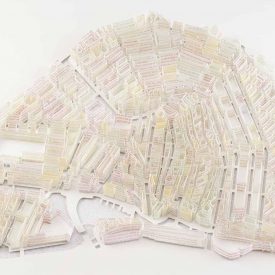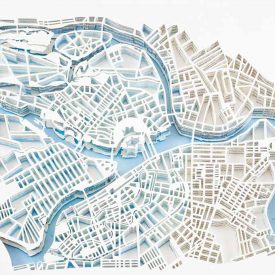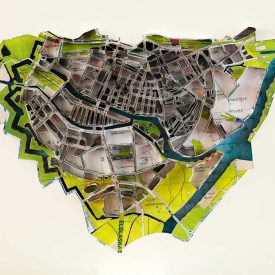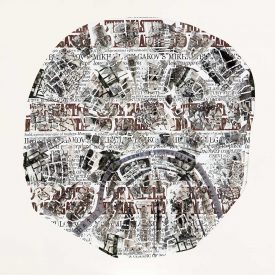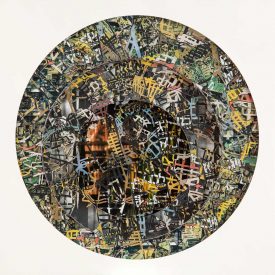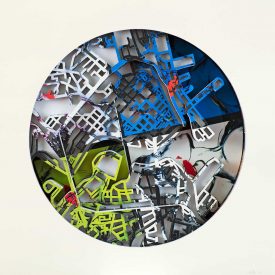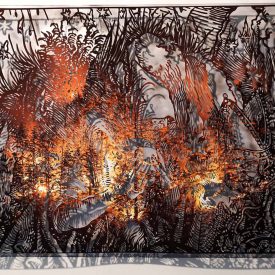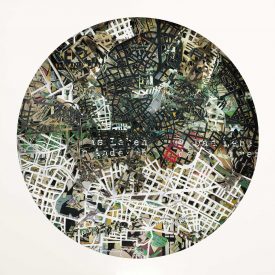The sculpture Berlin is comprised of three layers, the surface layer has a the street form of West Berlin cut from the film poster of “The Wings of Desire” by Wim Wenders. The sunken portion of East Berlin is cut from the film poster of “The Lives of Others” by Florian Henckel von Donnersmarck and underneath visible in a fragmented form are images from the posters and covers of the film “Berlin Alexanderplatz” by Rainer Fassbinder. The map used for the sculpture is an old map from 1932 of the prewar era.
The three films address three very specific periods and localities. The Berlin Alexanderplatz is set in 1928 and creates a portrait of a city and culture on the edge of catastrophic change. Alfred Doblin’s Berlin Alexanderplatz chronicles Franz Biberkopf’s release from prison and his gradual demise and downfall in the Berlin metropolis of the end of the 1920’s, this novel has been recognized as the great German novel of the city. “The language in Berlin Alexanderplatz was influenced by the rhythm of the elevated trains that ran past the window of Doblin’s Berlin study, shaped by such things as the noises of the the big city, the specific rhythms, the constant madness of an unceasing back and forth” Fassbinder. “Franz Biberkopf’s real antagonist is not Rheinhold, his two faced, wicked friend, the demon of the Berlin underworld, but rather the city itself – a gigantic, in its true dimensions unfathomable, constantly growing, rampant, endlessly changing being, a dark force that devours the “little man” and in the end leaves behind only the indigestible. Alexanderplatz is the scene of the encounter between Franz Biberkopf and the metropolis, the junction from which in those years the renewal of Berlin, in the sense of technical city planning, as a machine dominated community was to emanate” Thomas Steinfeld. The idea of the “little man” crushed by the forces of a city and Autocratic will power was something that preoccupied Pushkin in his depiction of St Petersburg in his poem “The Bronze Horseman” Ultimately almost everything from this claustrophobic world depicted here of pre war Berlin was set to be swept away and destroyed under the Nazi catastrophe of the 1930s and 40s.
What replaced this though was the division of the city, the wall, the East and West, the cold war. A city of empty lots, a sense of erasure in which the ghosts of the past could be felt all around. “The Lives of Others” addresses the Eastern experience, one of surveillance, fear, betrayal, the control of the Stasi secret police. In East Berlin, time and memory felt frozen, fenced in by a continuity of oppression and control. In the West the city existed as a strange marooned island of Western culture. The city of Berlin was effectively truncated geographically and also truncated from it’s own history. The physical holes in the Urban fabric, the ruins, the missing Potsdammer Platz could be equated with a severed memory. A memory with empty spaces born from the traumas of WW 2 and from this partial vacuum could emerge the extraordinary film by Wim Wenders which is at once a documentary of life in modern Berlin ( before the wall came down) and a metaphysical tale of the angels in charge of watching over Berlin. The quote used in the sculpture that is cut through the Berlin wall in the sculpture is from the film “How can it be that I, who am I, wasn’t before I was, and that sometime I the one I am, no longer will be the one I am”
Wender’s film is driven by the compelling existential questions of human life. “What are the relations between material and spiritual? Is there something beyond the material world? If there is some higher or divine realm, how can we enter into it or achieve communion with it? Is it true that transcendence can be attained through conquering the body? Is the body material and the mind, or part of the mind, spiritual? Is human history a parade of disasters finally leading nowhere (or leading, perhaps, to some terminal disaster)? Does anyone hear our voices? Do these voices resonate with some divine word of words? Our triumphs and perils – are they connected to some ultimate purpose, part of some cosmic conflict, or are they ultimately meaningless? Eric Mader -Lin.
